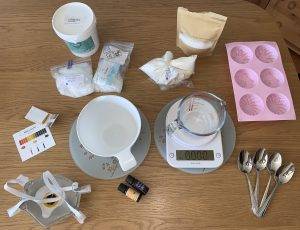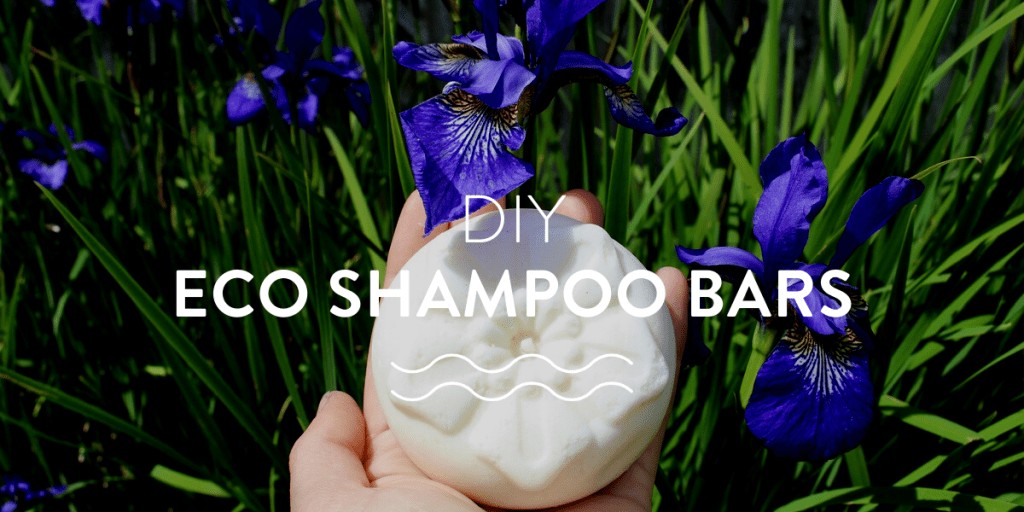Do you want to make your own sulphate-free, eco-friendly shampoo bars? With the added bonus of customising to your favourite scent and design? Then keep on reading for a quick and easy DIY guide to making them at home!
This recipe creates one bar, so if you can’t decide on just one fragrance you can make a batch of different scents and shapes.

Let’s begin with the chosen ingredients.
Cleaning surfactants
Shortened from surface-active agent, surfactants may act as cleansing, foaming or emulsifying agents. The cleaning properties come from their strong attraction with oil, grease / dirt, and water. When you rinse away the cleaning product, the dirt rinses away too.
This recipe uses 3 surfactants – think coconuts!
- Sodium Cocoyl Isethionate (SCI), commonly known as baby foam, has exceptional mildness. SCI is a wonderful base ingredient in cleansing bars for its mildly acidic pH. It’s a great match for our skin’s physiological range. It’s a solid surfactant, derived from coconut oil. It has proven to be less damaging to the skin barrier than sulphate-containing products.
- Sodium C14-16 Olefin Sulfonate (Bio-Terge AS90) is another mild, solid surfactant made from coconut oil. It performs a flash foaming effect and is a great alternative to create sulphate-free products.
- Cocamidopropyl Betaine (CAPB) is a versatile liquid compound derived from, you guessed it, coconut oil. Used in a bunch of personal care and cleaning products to clean and make suds.
*Safety Note* Ideally for this recipe, you’ll want the finest SCI and Bio-terge AS90 powders you can source, if not you’ll need to crush up larger chunks. Fine powders are easily inhaled, and nobody likes the taste of soap, so please make sure when playing with powders that you are wearing a dust particle mask!
Now for the nourishment
Cleaning is the main purpose of our shampoo bars of course, however we don’t our locks drying up. This is where our next ingredients come in. This recipe uses:
- Unrefined shea butter as the this has a naturally longer expiry date than treated products. But actually, you can use any solid brittle butter here such as cocoa, tucuma, or kukum butter.
- BTMS-25 is an emulsifying wax, keeping nourishing oils and water together. The wax creates a very fine coating on skin and hair, giving it an incredible conditioning ability. Leaves hair easy to brush through and all kinds of silky.
- Cetearyl alcohol is another waxy emulsifier, it keeps creamy mixtures from separating into oil and liquid. Made from a combination of cetyl alcohol and stearyl alcohol, which are both fatty alcohols derived from vegetable fats like coconut and palm oil.
The smellies
1oo% pure essential oils are a natural way to add fragrance. They are made from parts of plants like leaves, herbs, barks, flowers and rinds, which are concentrated into oils. What’s more, certain scents are thought to send chemical messages to the brain that affect our mood, known as aromatherapy.

Because good things should last forever
A preservative is essential to keeping your bar safe to reuse time and again. This one should last around 3 months! To ensure there is limited microbial growth after wetting, this recipe includes Plantaserve E Natural. Pick a broad-spectrum preservative, that will work over a wide pH range, to give your product that long shelf life (Liquid Germall Plus is another good choice).
Read: Chemicals in Cosmetics Impact Us and the Environment
Full list and amounts for Emily’s Eco Shampoo Bars (100g):
34g / 34% Sodium Cocoyl Isethionate
22g / 22% Sodium C14-16 Olefin Sulphonate (Bio-Terge AS90)
17g / 17% Cocamidopropyl Betaine
9g / 9% Shea butter
7g / 7% BTMS-25
9.5g / 9.5% Cetearyl alcohol
1g / 1% Bergamot essential oil (can pick whatever scent you want)
0.5g / 0.5% Plantaserve E Natural

Mixing and moulding method:
- First, put that dust mask on! Make sure its tight fitting.
- Start by weighing your two powdered surfactants and Cocamidopropyl Betaine before adding them to a small heat-resistant glass mixing container (e.g a Pyrex measuring jug).
- Mash everything together with the back of a spoon to make a stiff, putty-like paste.
- Next, weigh out the brittle butter (e.g. shea butter), BTMS-25 and cetearyl alcohol into a separate glass container.
- Melt the ingredients (either in the microwave for approximately 1 minute or you can also melt in a water bath).
- Pour this mixture into the surfactant mash and stir it up again with the back of your spoon. Wait until the mixture is cool to touch before moving on.
- Add your choice of essential oil (these bars used Bergamot oil, a gorgeously strong citrusy scent) and preservative before mashing again until everything is thoroughly incorporated.
- Press and push your mixture into your mould. You can use a piece of parchment paper to press on top and really work the mush into every gap.
- Freeze your bar for 30 minutes before un-moulding
- Finally, leave in a cool place to dry for a week. Two days of drying is sufficient, but the longer the drying time, the harder it will become and the less likely it will become a sloppy mess in the shower!
Top tip: make sure to place your bar somewhere it can dry between washes for the longest shelf life!
Hope you enjoy this recipe and feel confident to make your own eco shampoo bars now. Please get in touch with any questions and to share examples of your bars :)
Emily Jupp is a Marine Biologist and PADI scuba instructor from the UK. Passionate about living sustainably, keeping plastic free and caring for coral reefs. Follow her story @green.conch
Sources
PubMed Ghosh and Blankschtein. 2007. Why Is Sodium Cocoyl Isethionate (SCI) Mild to the Skin Barrier?
Skinchakra.eu
International Products Corporation – An easy guide to understanding surfactants
International journal of Tricology Diaz et al. 2014. The Shampoo pH can Affect the Hair: Myth or Reality?
Nenonatural.com
humblebeeandme.com







This Post Has 4 Comments
What is the Ph after making it
the pH is approximately 4.5 which is great because our scalp is 5.5 and hair shaft 3.7, so this bar is right in the middle of our hairs pH range! Hope that helps :)
Can we use more sci instead of sodium c16?
Yes, you can use sci up to 50% which is the safe limit! In fact Emily has since made bars with only sci and coca betaine as the surfactants. You can see more about this on her brand new website : greenconch.co.uk
Her blog called ‘Green shampoo – what makes a good shampoo?’ might be of particular interest to you. Hope that helps :)
Comments are closed.